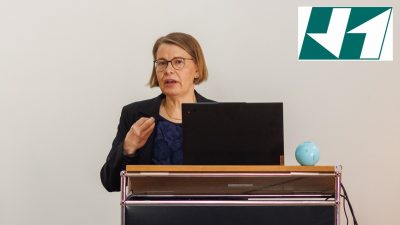
The 25th Topical Conference on Radio-Frequency Power in Plasmas took place from 19 to 22 May 2025 and attracted more than 130 participants. Our group leader, Mervi Mantsinen, delivered an invited talk at this conference reviewing key milestones from four decades of Ion Cyclotron Range of Frequencies (ICRF) physics on the Joint European Torus (JET), highlighting its significant contributions to fusion research and implications for future reactors.
JET, Europe’s leading tokamak device, has achieved exceptional performance surpassing its design specifications, operating with magnetic fields of up to 4 T, plasma currents of 7 MA, and auxiliary heating powers totalling 37 MW. Its versatile ICRF system, with a frequency range of 25–56 MHz, has enabled a wide array of heating and current drive experiments.
The talk emphasised three key areas of ICRF physics:
- ICRF physics mechanisms
- JET has demonstrated localised ion and electron heating, plasma rotation control and current drive using directed ICRF waves.
- Experiments confirmed the stabilisation of sawtooth behaviour by ICRF-accelerated ions, a phenomenon relevant to the behaviour of alpha particles in future reactors.
- Fast Ion Dynamics
- The first experimental evidence of ICRF-induced fast ion radial pinch was observed.
- Controlled shaping of fast ion populations and heating profiles was achieved using wave phasing and harmonic tuning.
- High-harmonic heating schemes were developed to support non-activated operation and diagnostic testing.
- ICRF heating in D-T plasmas
- Multiple ICRF heating schemes in D-T plasmas were tested and performed well, achieving a record-setting quasi-steady-state fusion yield.
- ICRF heating significantly boosted fusion performance, particularly through the acceleration of neutral beam deuterons.
The talk also addressed challenges associated with ICRF interactions with the plasma-facing components of the beryllium/tungsten wall. These increased impurity levels, but effective mitigation strategies were developed, such as tuning the antenna strap voltage and localised gas puffing.
In high-performance plasmas, it was demonstrated that ICRF heating helps to reduce central tungsten accumulation, thereby enhancing overall fusion performance.
The talk concluded with key takeaways for future reactors:
- Flexibility in ICRF design is crucial for enabling multiple heating and control functions.
- ICRF heating will be vital for achieving high ion temperatures in reactor-grade plasmas, where other methods may favour electron heating.
- Comprehensive modelling is essential to navigate ICRF’s nonlinear and complex behaviour.
- Fast ion confinement is highly effective in large plasmas, thereby reinforcing the viability of ion cyclotron damping as a heating mechanism.
This retrospective celebrated not only JET’s pioneering work, but also the enduring value of ICRF for next-generation fusion energy systems.

The 25th Topical Conference on Radio-Frequency Power in Plasmas took place in person from 19 to 22 May 2025 at Schloss Hohenkammer, close to Munich, Germany. The conference covered all aspects of electromagnetic waves in plasmas, including applications in magnetic fusion devices, RF plasma sources and basic plasma wave physics and technology:
- Plasma wave interactions, such as heating, current drive, diagnostics, and plasma control
- Applications of RF and microwave power in fusion devices, such as tokamaks, stellarators, spherical tori and reversed-field pinches, as well as other confinement concepts.
- Basic plasma wave physics
- RF and microwave applications to plasma sources for materials processing, space propulsion and ionospheric and space plasmas.
Organised by the Max Planck Institute for Plasma Physics, the conference attracted more than 130 participants. A total of 31 talks and 90 posters were presented. For more details, see the conference website.
We look forward to the next conference, which will be held in Princeton, USA, in October 2026.
